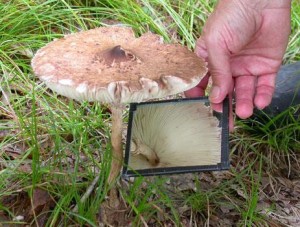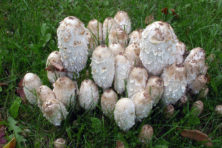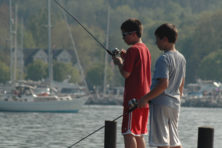Mushrooms, a world of wonder at your feet
- Share
- Tweet
- Pin
- Share
The past three droughty summers have been very unsatisfactory for our interest in mushrooms. Finally, with around 4.8 inches of rain at our place in August, more than June and July combined, conditions are finally improving for the appearance of these fascinating fungi (FUN-ji).
My wife Charlotte has seriously pursued mycology, the study of fungi, for the past 37 years and likes to quote a favorite saying of the North American Mycological Association (NAMA) to which she belongs: “Mushrooms, a world of wonder at your feet.”
The rain surely has helped not only farmers, fruit growers and gardeners but also those whose autumns are never complete without good harvests of edible fungi. The precipitation has also brought relief to those hikers whose outings are greatly enhanced by dozens of different species of mushrooms, adding color and interest to the forest floor as wildflowers do in spring.
My wife and I hiked recently at Newport State Park with our friends, Don and Beth of Kenosha, budding students and outstanding finders of wild mushrooms. It didn’t take us long to discover 12 species, most new for Charlotte’s list for the park which now stands at 113. The only reason the list for Whitefish Dunes State Park includes 219 species is that the park is quite close to our home, contains outstanding “eco niches” for the growth of mushrooms, and we frequently hike there. Her Door County total of fungi, as of this Labor Day, 2009, stands at 542 species.
Bear in mind that it is illegal to collect mushrooms, or to remove anything else for that matter, in all Wisconsin State Natural Areas. This does not include most state park property, although there do exist some small State Natural Areas within some of the parks. Charlotte, with her background and expertise with mushrooms, has been given special permission to collect judiciously in these areas only for the purpose of identification and to further the understanding of the natural history there.
Naturally we’re on the lookout for edible species of mushrooms each fall and have several favorite woods, including our own, where we search for them. A really excellent collecting day might result in returning home with gypsys, Rozites caperata (roe-ZY-teez cap-er-AY-ta), parasols, Macrolepiota procera (mak-ro-lep-ee-O-ta pro-SEER-a), honey caps, Armillariella mellea (ar-mi-lair-ee-EL-a MEL-ee-a), earth prunes, Entoloma aboritivum (en-to-LOW-ma a-BOR-ti-vum), hedgehogs, Dentinum repandum (DEN-ti-num re-PAN-dum), and black trumpets, Craterellus cornucopeoides (cray-ter-EL-lus corn-you-co-pee-EYE-deez). Most people wouldn’t visualize gypsys, parasols, honey caps, hedgehogs, earth prunes and black trumpets as sounding very appetizing, but they rank among our favorites.
Included among the various features in Charlotte’s accurate identification of the 542 Door County fungi species to date has been the study of each species’ spores using our microscope, with a 970-power oil-immersion lens that also contains a size measuring scale. The parasol mushroom, for example, has smooth, white or clear, thick-walled, and broadly ellipsoid spores, each having an apical pore. Their size is approximately 9 by 14 microns. One micron is equal to one 125,000th of one inch. Knowing the color, shape and size of mushroom spores is critical to proper identification of many species.
Many of the beautiful woody fungi that people see and enjoy in the forests belong to a group called polypores, meaning many-pored. The tube layers that line the underside of the caps appear to consist of an incredible number of tiny pinholes, some so small that they have to be seen with a magnifying lens. These are the tubes containing the spores.
What is so amazing about the polypores, as well as many other fleshy mushrooms, is that they are the major group of absolutely indispensable wood-rotting fungi in a healthy woods. This will come as a surprise to those people who consider all fungi to be harmful to trees. Even though there are some fungi extremely damaging to trees, including our great favorite edible, honey caps, most fungi are actually very important. Through the process of decay they prevent the build-up of forest debris, thereby reducing the chances of fire and also providing vital open spaces for the growth of new trees and other plants. Woody and other types of fungi literally invented the word recycle. Indeed, they are the forest’s recyclers magna cum laude!
Many people wouldn’t dream of eating a wild mushroom, preferring to limit their association with this mysterious and fascinating group of wild plants to their pure esthetic value. At the other end of the scale are those folks who are so eager to eat wild mushrooms that they would be perfectly willing to trust our determination of “edible or poisonous” from their description over the telephone. These same people will pay hundreds of dollars to a doctor or lawyer for medical or legal advice, yet they expect free advice from us regarding wild mushrooms, a food that could mean life or death!
Obtain a good mushroom field guide including one we highly recommend, “Mushrooms of Northeast North America,” by George Barron. It contains all excellent colored photographs and other excellent learning features. Spend some time carefully studying and condensing the first 30 or so pages and then take the guide with you into the field for some fun.
Should you finally and proudly have reached the stage of accurately identifying one or two species of edible mushrooms and are now ready to eat them, don’t over-indulge. Go easy at first. Never eat more than one new mushroom at a time. If you get sick you won’t know which of several new ones was the culprit. Just as some people are allergic to milk or chocolate, so too are some individuals sensitive to various mushrooms.
As Charlotte often tells her students of wild fungi, “Walk slowly and observe carefully. Get down to the level of the mushrooms!”
The mushroom season has finally arrived!







